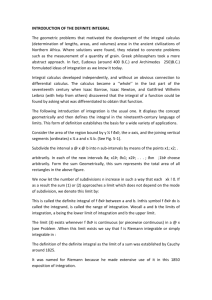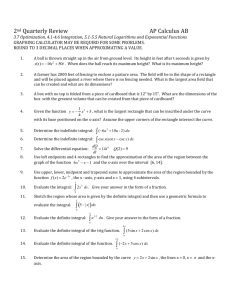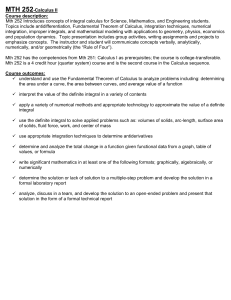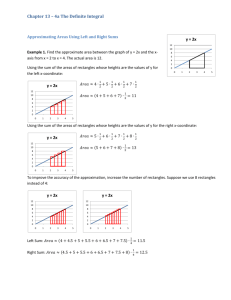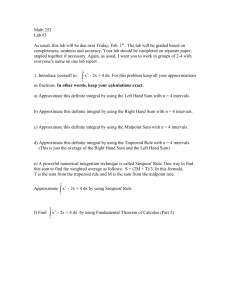Riemann Sums & Integral Expressions for Area
advertisement
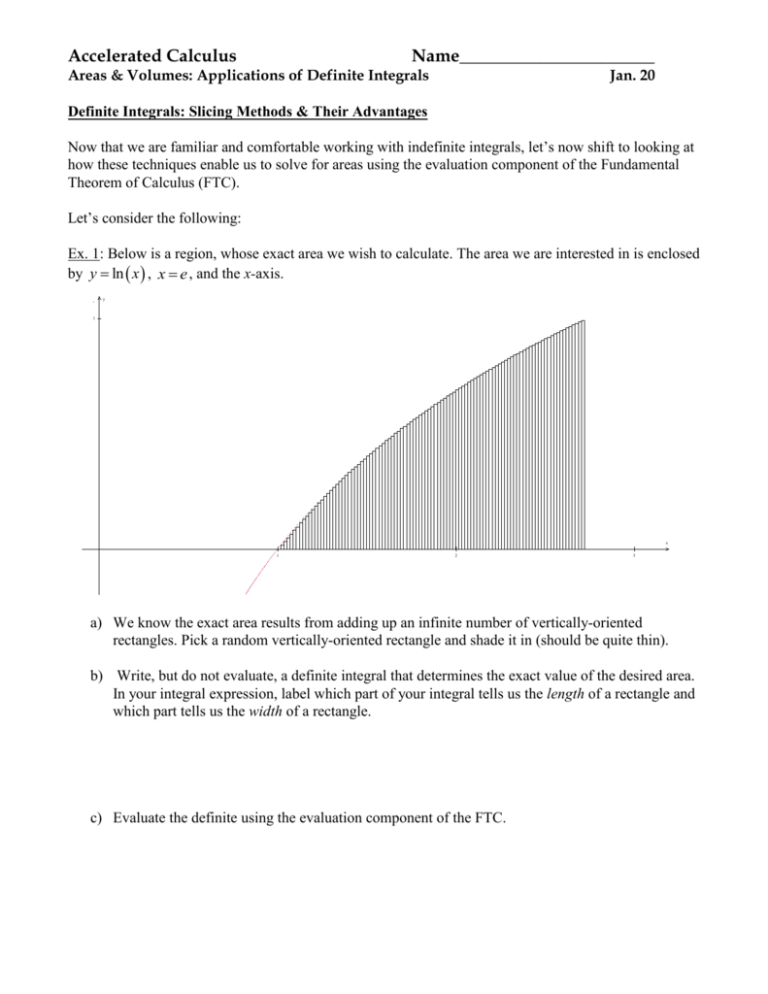
Accelerated Calculus Name______________________ Areas & Volumes: Applications of Definite Integrals Jan. 20 Definite Integrals: Slicing Methods & Their Advantages Now that we are familiar and comfortable working with indefinite integrals, let’s now shift to looking at how these techniques enable us to solve for areas using the evaluation component of the Fundamental Theorem of Calculus (FTC). Let’s consider the following: Ex. 1: Below is a region, whose exact area we wish to calculate. The area we are interested in is enclosed by y ln x , x e , and the x-axis. y x a) We know the exact area results from adding up an infinite number of vertically-oriented rectangles. Pick a random vertically-oriented rectangle and shade it in (should be quite thin). b) Write, but do not evaluate, a definite integral that determines the exact value of the desired area. In your integral expression, label which part of your integral tells us the length of a rectangle and which part tells us the width of a rectangle. c) Evaluate the definite using the evaluation component of the FTC. Accelerated Calculus Clearly, the area of this region is unique and should not depend on its location or its orientation. This may lead us to consider if we can still use the idea of adding up an infinite number of rectangles, but to construct our rectangles using a different slicing method. Consider the same area we examined earlier, enclosed by y ln x , x e , and the x-axis. y x d) Suppose we use infinitely thin rectangles, but now oriented horizontally. Shade-in a horizontallyoriented rectangle (again, this should be quite thin). e) Write, but do not evaluate, a definite integral that determines the exact value of the desired area. In your integral expression, label which part of your integral tells us the length of a rectangle and which part tells us the width of a rectangle. Note: this process will require you to re-write your functions in terms of y – including your limits of integration. f) Evaluate the definite using the evaluation component of the FTC. As we would expect, you should get the same area value you did when you used, what we will now call, dx slices. This is important! Do not advance unless your calculation matches your answer to part c. Accelerated Calculus Hopefully you are now aware of one reason one might consider setting up a definite integral using horizontally vs vertically-oriented rectangles. Let’s look at another scenario, different in nature. Ex. 2: Below is a region, whose exact area we wish to calculate. The area we are interested in is enclosed by y x , y 2 x 2 , and the x-axis. y x a) Using vertically-oriented rectangles, write (but do not evaluate) an integral expression that determines the exact value of the desired area. As you did before, in your integral expression, label which part of your integral tells us the length of a rectangle and which part tells us the width of a rectangle. Note: this process will require you to write TWO integral expressions! b) Evaluate the definite using the evaluation component of the FTC Accelerated Calculus Now, let’s consider looking at this same exercise from a different perspective. Again, the area we are interested in is enclosed by y x , y 2 x 2 , and the x-axis. y x c) Using horizontally-oriented rectangles, write (but do not evaluate) an integral expression that determines the exact value of the desired area. As you did before, in your integral expression, label which part of your integral tells us the length of a rectangle and which part tells us the width of a rectangle. d) Evaluate the definite using the evaluation component of the FTC Take-Away Question: Based on these two exercises, what factors should one consider when constructing an expression to determine an enclosed area? Accelerated Calculus Re-visiting Area: Forget the Coordinate Axes We just took a look at enclosed areas on coordinate axes and set up definite integrals to represent mathematical expressions for these areas. All these coordinate axes allowed us to do was to formalize a fundamental process so that we could understand how these areas could be viewed using vertical (dx) or horizontal (dy) slices to represent rectangles. This fundamental process is not dependent on these coordinate axes, so let’s examine this process in a more general sense. Consider the following areas. For each of the exercises, using the diagram provided, perform the following tasks (the first two have been completed for you, to serve as a model). a) Write a Riemann sum representing the area b) Write a definite integral representing the same area c) Evaluate the integral by hand using FTC AND “check” your answer (via geometry or your calculator) 1) n A lim 3 x a) Riemann Sum: n b) Definite Integral: A 5 0 k 1 3 length 5 5 0 0 length width where x 5 n dx width c) A 3 dx 3 x | 3(5) 3(0) 15 sq. units CHECK: Using Geometry, ARECT length width, so ARECT 15 Accelerated Calculus 3) a) Riemann Sum: n 3 A lim 3 h h n 5 width k 1 where h 5 n length (use similar s) b) Definite Integral: 5 3 A 3 x dx 0 5 width length 5 3 3 5 3 3 15 2 2 sq. units c) A 3 x dx 3x x 2 | 3 5 5 3 0 0 0 10 0 10 10 2 5 CHECK: Using Geometry, A 1 1 15 base height , so A 3 5 2 2 2 5) a) Riemann Sum: ________________________________________ b) Definite Integral: ________________________________________ c) Accelerated Calculus 7) a) Riemann Sum: ________________________________________ b) Definite Integral: ________________________________________ c) Adding a Dimension: A Look at Volume Now, let’s use this similar process to move into three-dimensions and take a look at volumes of objects, using the idea of creating a “slice” and focusing on a general expression to represent the volume of each of these “cross-sectional slices”. When looking at a slice of an object, each cross-sectional area slice should be a very familiar geometrical shape – i.e. circle, rectangle, and triangle. When summed, these cross-sectional areas will create, in these cases, recognizable objects such as cones, cylinders, spheres, and pyramids. While certainly not all objects can be classified into these forms, the study of “cross-sectional areas” will allow us to work with, and calculate, the area of virtually any object. Let’s embark on a little journey, similar to what we just did with areas, to look at infinite sums of “crosssectional areas”! Accelerated Calculus Consider the following objects. For each of the exercises, using the diagram provided, perform the following tasks (the first one is completed for you, to serve as a model). a) Write a Riemann sum representing the volume b) Write a definite integral representing the same volume c) Evaluate the integral by hand and “check” your answer (via geometry or your calculator) 9) n a) Riemann Sum: 2 V lim 2 x width n k 1 where x 9 n cross-sectional area b) Definite Integral: 2 V 2 dx width 0 9 cross-sectional area 9 2 c) V 2 dx 4 x | 4 9 4 0 36 cu. units 0 0 9 2 CHECK: Using Geometry, VCYL Area of base height, so VCYL 2 9 36 Accelerated Calculus 11) a) Riemann Sum: ________________________________________ b) Definite Integral: ________________________________________ c) 13) a) Riemann Sum: ________________________________________ b) Definite Integral: ________________________________________ c)

